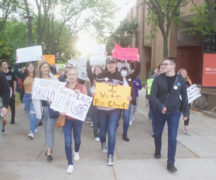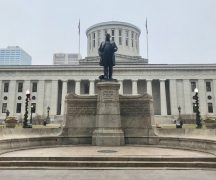By Susan Tebben
There was a Ferris wheel destined for Athens, Ohio.
When Mayor Steve Patterson was thinking of ideas to help boost participation in the 2020 census, he and other officials came up with one giant reward for college students’ participation.
“Everyone that brought proof that they’d filled out the census would get a free ride, and we were going to put it in the center of town,” Patterson said.
But the sun set on that idea as a pandemic closed Ohio University to in-person classes, and a stay-at-home order negated gatherings of more than 10 people.
Now, not only is the city not having fun uptown, it is concerned that the data that brings them needed funding for everything from school lunches to highway construction could be at risk. Statewide, the census decides representation in government, FEMA dollars and small business loans.
For colleges specifically, the census can indirectly affect their ability to draw down student loans and receive Pell grants, according to Tracy Najera, of the Ohio Census Advocacy Coalition.
Najera said these indirect effects come with direct effects to the towns that house these colleges and universities, which could lose the qualifications for community development block grants and other parts of the local economy.
As of May 3, Athens County had a self-response rate of 52%, according to the U.S. Census website, compared to the state’s 61.7% response rate. In just the campus area alone, census responses are just above 28%.
In 2010, the final self-response was 63% in Athens County, and the state had a total self-response rate of 69%.
Other colleges are seeing similarly low participation. The Ohio State University’s main campus currently has a 16.6% response rate around its campus. The city of Gambier, where Kenyon College sits, has a 25.1% rate of census response.
Patterson said not being able to directly interact with the college students who would be reporting Athens as their home for the year means they have to trust that those students will be including their voice. Without them, the counts could affect the city for a decade to come.
“To have undercounts that we’re experiencing right now is a big loss, and it’s a ten-year window that you have to think about,” Patterson said in an April interview. “We’re not going to get a recount until 2030.”
A study on the census from The George Washington University estimated that every person in Ohio missed in the census could represent a $1,200 loss in federal funding per year for the ten years in between counts.
Those losses would be horribly timed, as the city (like many other cities in the state) is looking at double-digit expenditure cuts and losses in state and federal funding because of COVID-19.
Along with what locals are doing to try to get to those college students, the Census Bureau adjusted the way in which they count the students.
For those living in on-campus housing, the census plans to count them through the Group Quarters Operation, “which counts all students living in university owned housing,” according to the bureau. That operation also counts nursing homes, prisons and halfway houses, among others.
***
More from Ohio Capital Journal:
Trump’s critics warn his order to keep meat plants open imperils workers
WASHINGTON — Democratic senators are accusing President Donald Trump of putting workers at risk by ordering meat and poultry processors to remain open during the COVID-19 pandemic.
Senate Democrats including Democratic Ohio U.S. Sen. Sherrod Brown are asking Trump to amend an executive order he signed last week, which declared meat plants to be “critical infrastructure” and ordered his administration to ensure that they continue to operate.
Trump’s order comes as slaughterhouses around the country have emerged as hot spots for the spread of COVID-19, forcing closures in some locations and disrupting food supply chains.
The Centers for Disease Control and Prevention reported that there were at least 115 meat or poultry processing facilities with COVID-19 cases by April 27. More than 4,900 workers had been diagnosed with the disease, and 20 deaths linked to COVID-19 had been reported among those workers. READ MORE
State representative won’t wear mask because faces are the ‘likeness of God’
Having already claimed that face masks do not work, state Rep. Nino Vitale offered a new reason Monday why he wouldn’t wear a mask during the ongoing COVID-19 pandemic — because faces are the “likeness of God.”
Vitale, a Republican from Urbana, has been among the most outspoken critics against the health orders issued by Gov. Mike DeWine and Ohio Department of Health Director Dr. Amy Acton. He has called their COVID-19 response unconstitutional and in recent days has openly encouraged Ohioans to ignore their shutdown orders.
On Monday, Vitale took to Facebook to share more thoughts about wearing face masks.
“This is the greatest nation on earth founded on Judeo-Christian Principles,” he wrote on his official page. “One of those principles is that we are all created in the image and likeness of God. That image is seen the most by our face. I will not wear a mask.” READ MORE





